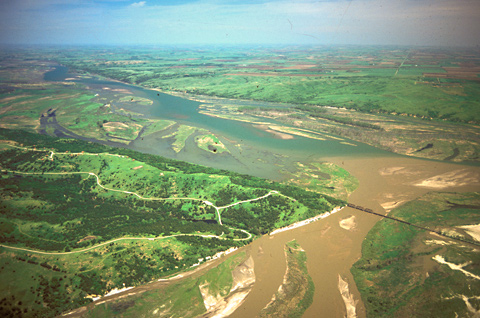Niobrara and Missouri River Confluence
View north, down the Niobrara, up the Missouri
© 2000 Airphoto—Jim Wark.
The expedition set out from camp on the morning of 4 September 1804 with a “verry Cold” southeast wind at their backs. It soon shifted to the south and “blew very hard,” according to Sergeant Ordway. “We hoisted Sail,” he wrote, and “ran verry fast a Short time. Broke our mast.” That was the fourth such mishap since they left Camp Dubois on 14 May. The party “came to”—landed—on the arrow-shaped point somewhere beyond the left end of the bridge, on the west side of the Niobrara. There the men made a new mast from the trunk of a tall, sturdy red cedar, which apparently lasted at least until they reached the Mandan villages near the end of October.
French travelers had named this river L’Eau qui Court, or “The Water that Rushes,” but which the Omaha Indians called, more suitably, n”ubthatha, meaning “wide river.” Early settlers re-spelled the Indian name more or less phonetically as Niobrara. Clark measured it at “152 yards wide at the mouth & 4 feet Deep Throwing out Sands like the Platt (only Corser) forming bars in its mouth.” It was, he later wrote, “not navigable a single mile,” but he himself explored it three miles above its mouth, “to a butifull Plain on the upper Side” where the Poncas once had a large village.
The Niobrara apparently hasn’t changed its course much at this confluence, but the Missouri may have moved nearly a mile to the south sometime within the past two hundred years, leaving a deposit of rich bottomland in the present state of South Dakota. The Missouri’s width here today, including the numerous sandbars and islands, is largely the result of silt dropped as the current slows upon entering the shallows at the head of the reservoir, which has been impounded by Gavin’s Point Dam, 25 miles downriver.
The point on which the expedition camped is now a state park. Near the opposite point, just out of the photo at lower right, is the village of Niobrara, Nebraska, headquarters of the small Indian reservation that is shared by the Santee Sioux and the Poncas.
From Discovering Lewis & Clark from the Air
Photography by Jim Wark
Text by Joseph Mussulman
Reproduced by permission of Mountain Press

